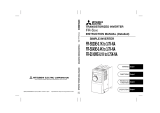
II
3.2.1 Names and functions of the operation panel................................................... 61
3.2.2 Monitor display is changed by pressing the [MODE] key................................ 62
3.2.3 Monitoring........................................................................................................62
3.2.4 Frequency setting............................................................................................ 63
3.2.5 Parameter setting method...............................................................................63
3.2.6 Operation mode...............................................................................................66
3.2.7 Help mode....................................................................................................... 66
3.3 Operation .............................................................................................................. 68
3.3.1 Pre-operation checks....................................................................................... 68
3.3.2 PU operation mode (Operation using the operation panel)............................. 69
3.3.3 External operation mode (Operation using the external frequency setting
potentiometer and external start signal)..........................................................71
3.3.4 Combined operation mode 1 (Operation using both external start signal and
operation panel)............................................................................................... 72
3.3.5 Combined operation mode 2........................................................................... 73
CHAPTER 4 PARAMETERS 75
4.1 Parameter List ...................................................................................................... 76
4.1.1 Parameter list..................................................................................................76
4.1.2 List of parameters classified by purpose of use .............................................. 82
4.1.3 Parameters recommended to be set by the user ............................................ 84
4.2 Parameter Function Details................................................................................. 85
4.2.1 Torque boost (Pr. 0, Pr. 46).............................................................................85
4.2.2 Output frequency range (Pr. 1, Pr. 2, Pr. 18)................................................... 86
4.2.3 Base frequency, base frequency voltage (Pr. 3, Pr. 19, Pr. 47)...................... 87
4.2.4 Multi-speed operation
(Pr. 4 to Pr. 6, Pr. 24 to Pr. 27, Pr. 232 to Pr. 239)..........................................88
4.2.5 Acceleration/deceleration time (Pr. 7, Pr. 8, Pr. 20, Pr. 21, Pr. 44, Pr. 45) ..... 89
4.2.6 Electronic thermal relay function (Pr. 9, Pr. 48)............................................... 91
4.2.7 DC injection brake (Pr. 10 to Pr. 12)................................................................ 92
4.2.8 Starting frequency (Pr. 13) .............................................................................. 93
4.2.9 Load pattern selection (Pr. 14)........................................................................ 94
4.2.10 Jog operation (Pr. 15, Pr. 16).......................................................................... 95
4.2.11 Stall prevention and current restriction (Pr. 22, Pr. 23, Pr. 66, Pr. 156)..........96
4.2.12 Acceleration/deceleration pattern (Pr. 29)....................................................... 99
4.2.13 Regenerative brake duty (Pr. 30, Pr. 70).......................................................100
4.2.14 Frequency jump (Pr. 31 to Pr. 36)................................................................. 101
4.2.15 Speed display (Pr. 37)................................................................................... 102
4.2.16 Frequency at 5V (10V) input (Pr. 38)............................................................. 103
4.2.17 Frequency at 20mA input (Pr. 39)................................................................. 103
4.2.18 Up-to-frequency sensitivity (Pr. 41)............................................................... 104
4.2.19 Output frequency detection (Pr. 42, Pr. 43)...................................................104






















